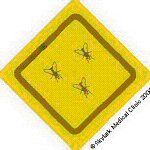 |
 
Leishmaniasis
Is found near the Mediterranean, Africa, China and Central and South
America. Female Sandflies transmit this protozoa infection to humans
from dogs or rodents. Other ways to catch it are from blood transfusions,
sexual intercourse or from mother to child.
Sandflies bite at night. They only fly at lowr altitudes above
ground so being bitten can be avoided by sleeping above ground (hammock
or second story of a house). They may be small enough to slip between
mosquito nets, but if the nets are treated with permethrin they
will deter flies.
Sand flies are tiny flies that breed in moist debris, like humid
places, or damp soil rich in humus. They are also linked to poor
housing conditions or forest/rain forest ecosystems where they like
to breed in rotting leaves between the buttresses of tree trunks.
Usually a sandfly bite has a non- swollen circle around it. Sometimes
biting midges, near beach resorts, are referred to as sandflies,
but are in fact not.
Leishmaniasis is grouped into 3 types:
1. Cutaneous (Aleppo boil or button, Baghdad boil,
Baune ulcer, Delhi boil, oriental sore, tropical sore). The Sandflies
bite first appears as red patches that gradually enlarge and ulcerate.
Next nodules form that are itchy, firm, yet painless. Without treatment
these heal slowly, often with scarring. Cutaneous Leishmaniasis
is diagnosed by biopsy. Intravenous medication is needed to treat
this.
2. Visceral Leishmaniasis (dumdum fever, Kala-azar).
Most cases of this type are in India, Bangladesh, Nepal, Sudan,
and at the Mediterranean. 'Kala-azar' is Hindu for black sickness
as the disease causes darkening of the face, limbs and abdomen.
They tend to affect young people and the incubation period can last
months to years. Symptoms may start during incubation period, which
can last months to years. Initially a mild fever with bouts of extreme
sweating. With progression - weight loss, fatigue, anorexia, nausea,
abdominal pain and diarrhea develop. Enlargement of the spleen,
liver and lymph nodes occur. Untreated disease is fatal. Diagnosis
is confirmed with blood tests. Intravenous drugs teat this disease.
3. Mucocutaneous Leishmaniasis (American Leishmaniasis,
Chiclero ulcer, Espundia, Forest yaws, Uta). Present in South and
Central America. Initially painful, itchy nodules occur, which heal
within a few months. Years late 40% of these develop ulcers at face
and mouth, which cause disfigurement. Diagnosis may be made from
biopsy or blood tests. Medication and surgery are often unsatisfactory.
Leishmaniasis is acquired through the bite of the female sandfly,
which generally bite at night. They are inactive during the day
and like to breed in moist dark areas. Bites can be prevented through
protective clothing at evening and night, elevation of bedding so
it is not on the ground and DEET.
Cutaneous Leishmaniasis involves skin infection and is caused by
Leishmaniasis major, Leishmaniasis aethiopia, and Leishmania tropica.
Leishmania minor is a rural disease affecting wild rodents. Tourists,
hunters and others living in these areas are vulnerable. Skin lesions
are large, wet and multiple and rarely spread.
Leishmania aethiopia is found in Ethiopia and Kenya and typically
infects the animal reservoir, the rock hyrax. Infection by tourists
is rare. Leishmania tropica is an urban disease found in the Middle
East and Asia. Leishmania brazilensis (in South America) can lead
to distinctive mucocutaneous lesions.
Visceral Leishmaniasis (also known as Kala-azar) is caused by Leishmania
donovani. It is common in Kenya and Sudan. Transmission may be human
to human but outbreaks are usually in isolated areas so tourists
are not usually affected. Infected patients may present with an
acute illness after 4-6 months. Symptoms include high fever and
severe sweats.
Progression to splenomegaly, hepatomegaly, lymphadenopathy and wasting
with anemia, but only 5% go on to more severe symptoms.
HIV infected travelers and immunocompromised people will be affected
more.
Leishmaniasis
links:
CDC
http://www.cdc.gov/travel/diseases/leishmaniasis.htm
WHO
control of Leishmaniasis
http://www.who.int/emc/diseases/leish/
Brown
University (A scientific summary)
http://www.brown.edu/Courses/Bio_160/Projects2000/Leishmaniasis/
Leishmaniasis
Slide Discussion by Dr David Humber
http://homepages.uel.ac.uk/d.p.humber/powerpoint/leishmaniasis/
Medicine
sans frontiers Doctors without borders Leishmaniasis
The forgotten disease
http://www.accessmed-msf.org/campaign/lsh01.shtm
|



